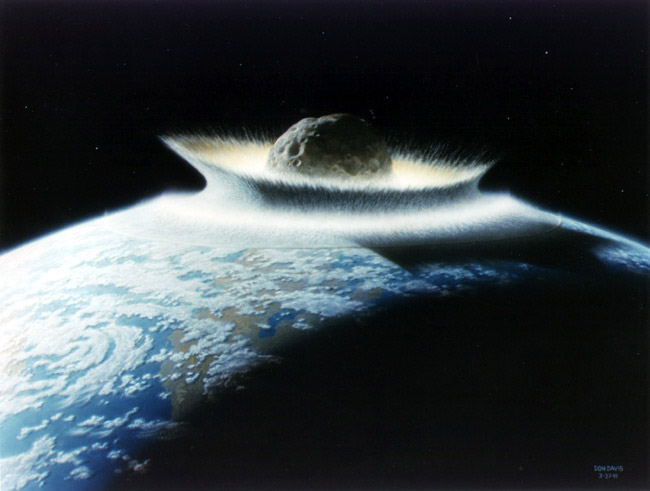NASA Panel Calls for Asteroid Defense Office

BOULDER,Colo. ? Protecting Earth from menacing space rocks that could impactour planetshould be designated a top-level NASA strategic goal, according to anagency taskforce. To achieve that goal, NASA should establish aPlanetary DefenseCoordination Office to oversee the effort, the task force said.
Theseven-person NASA Advisory Council?s Ad-Hoc Task Force on PlanetaryDefensecalled for the new asteroid-watching office after reviewing ideas fordetecting, characterizing and deflecting threatening near-Earthobjects (NEOs), as well as discussing internationalcoordination to dealwith the issue.
The task force, which met here July 8-9, is reviewing its advocacy of launching aninfrareddetector spacecraft placed into a Venus-like orbit to provide along-distance lookoutfor NEOs, which could speed up surveillance duties by decadescompared to relyingsolely on ground-based observations.
Pro-activeprevention
Formerastronauts Russell Schweickart and Tom Jones are co-chairs of theAd-Hoc TaskForce, which is made up of members from academia and scientificinstitutionsincluding NASA.
"Atthe end of our process, our recommendations will go to the NASAAdministratorand for the first time will address the overall issue of protecting theplanetfrom asteroidimpacts," Schweickart told SPACE.com. "Those recommendationswillinclude not only finding NEOs that potentially pose a threat, butpro-activeprevention of impacts?and working with the international community inorder tobe prepared to take that kind of action," he said. [Gallery:Holes in the Earth]
Thegroup?s output "will be the first time NASA will have that kind ofserious, internal set of recommendations," Schweickart added.
Get the Space.com Newsletter
Breaking space news, the latest updates on rocket launches, skywatching events and more!
"Itreally is a turning point," said Don Yeomans, a task force member andManager of NASA?s Near-Earth Object Program Office at the JetPropulsionLaboratory in Pasadena, Calif.
"Fordecades we were bumping along, barely aware that there were near-Earthobjects.When NASA got involved in the mid-1990s? there?s been a dramaticincrease inthe discovery rate. It was sort of an ?ah-ha? moment for the communityin termsof science," he told SPACE.com.
Emergencymanagement issues
Thetask force members are investigating using off-the-shelf hardware tofabricatea ground-based short-term warning capability. Such gear could providemany daysor hours of warning about smaller, incomingspace rocks. Furthermore, using commercially-availableequipment could helpbuild a system that?s inexpensive but powerful, and can be easilydeployedaround the globe.
Thetask force is also considering emergency management matters, such aswhat to doif Earth appears poised for a bruising impact.
Speakingto that topic via remote conferencing was Dennis Mileti, professoremeritus andformer director of the Hazards Center at the University of Colorado atBoulder.He is an expert on societal aspects of hazards and disasters.
IfNASA takes a lead role in planetary defense, the job of detectingthreateningNEOs falls to the agency, Mileti advised. It is important, he said, tostructure a highly reliable warning and messaging system, coupled witha publiceducation campaign.
BlendingNEO space scientists with emergency responders and disaster managementagencies? including the Department of Homeland Security ? is critical, Miletisaid. "That'sreally mixed soup to weave together," he told the task force.
Mileti'smessage to NASA: "They'll need to provide the leadership to reach outtothe emergency management community ? because it will not go the otherwayaround."
- Images? Asteroids Up Close, Astronautson Asteroids
- NASA'sNew Asteroid Mission Could Save the Planet
- Willan Asteroid Hit Earth? Are We All Doomed?
LeonardDavid has been reporting on the space industry for more than fivedecades. Heis past editor-in-chief of the National Space Society's Ad Astra andSpaceWorld magazines and has written for SPACE.com since 1999.
Join our Space Forums to keep talking space on the latest missions, night sky and more! And if you have a news tip, correction or comment, let us know at: community@space.com.

Leonard David is an award-winning space journalist who has been reporting on space activities for more than 50 years. Currently writing as Space.com's Space Insider Columnist among his other projects, Leonard has authored numerous books on space exploration, Mars missions and more, with his latest being "Moon Rush: The New Space Race" published in 2019 by National Geographic. He also wrote "Mars: Our Future on the Red Planet" released in 2016 by National Geographic. Leonard has served as a correspondent for SpaceNews, Scientific American and Aerospace America for the AIAA. He has received many awards, including the first Ordway Award for Sustained Excellence in Spaceflight History in 2015 at the AAS Wernher von Braun Memorial Symposium. You can find out Leonard's latest project at his website and on Twitter.









